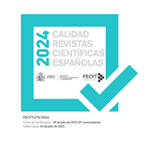Signalling digression in Spanish and English: Evidence from parliamentary discourse
Resumen
Digression is a discourse function that is identifiable and distinct from other similar functional strategies, and varies cross-linguistically. This paper investigates the way speakers of Spanish and English digress from their main discourse topics and how these transitions are marked. Once digression is defined by the proposal of four features considered to be inherent in this concept, the paper focuses on so-called 'digression formulating phrases', recurrent expressions which make explicit reference to the digression and signal that a new direction with respect to topic is proposed. The paper thus adopts a less common than the usual approach to discourse coherence and digression, whose literature has largely focused on discourse markers. The dataset, extracted from a corpus of parliamentary discourse, is analysed in an attempt to address two research questions. I investigate, first, the frequency and distribution of the selected digression formulating phrases in the two languages, and discern which of the two contexts of digression (i.e. beginnings and ends) is more highly marked, and, second, their use in connection to aspects such as syntactic configuration and position, and co-occurring features of semantic and pragmatic meaning. The contrastive perspective adds precision and richness to the treatment of digression.
Descargas
Descarga artículo
Licencia
La revista Círculo de Lingüística Aplicada a la Comunicación, para fomentar el intercambio global del conocimiento, facilita el acceso sin restricciones a sus contenidos desde el momento de su publicación en la presente edición electrónica, y por eso es una revista de acceso abierto. Los originales publicados en esta revista son propiedad de la Universidad Complutense de Madrid y es obligatorio citar su procedencia en cualquier reproducción total o parcial. Todos los contenidos se distribuyen bajo una licencia de uso y distribución Creative Commons Reconocimiento 4.0 (CC BY 4.0). Esta circunstancia ha de hacerse constar expresamente de esta forma cuando sea necesario. Puede consultar la versión informativa y el texto legal de la licencia.











